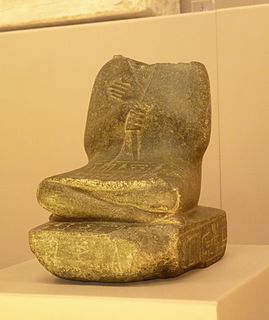
In Egyptian mythology, Heryshaf, or Hershef, transcribed in Greek as Harsaphes or Arsaphes was an ancient ram deity whose cult was centered in ancient Heracleopolis Magna. He was identified with Ra and Osiris in ancient Egyptian religion, as well as Dionysus or Heracles in the interpretatio graeca. The identification with Heracles may be related to the fact that in later times his name was sometimes reanalysed as ḥrj-šf.t "He who is over strength". One of his titles was "Ruler of the Riverbanks". Heryshaf was a creator and fertility god who was born from the primordial waters. He was pictured as a ram or a man with a ram's head.

The Eye of Horus, also known as wadjet, wedjat or udjat, is an ancient Egyptian symbol of protection, royal power, and good health. The Eye of Horus is similar to the Eye of Ra, which belongs to a different god, Ra, but represents many of the same concepts.

Tomb KV42 is an ancient Egyptian tomb located in the Valley of the Kings in Egypt. It was constructed for Hatshepsut-Meryetre, the wife of Thutmose III, but she was not buried in the tomb. It was reused by Sennefer, a mayor of Thebes during the reign of Amenhotep II, and by several members of his family. The tomb has a cartouche-shaped burial chamber, like other early Eighteenth Dynasty tombs.

Khaankhre Sobekhotep was a pharaoh of the Thirteenth Dynasty of Egypt during the Second Intermediate Period.

Sekhemre Seusertawy Sobekhotep VIII was possibly the third king of the 16th Dynasty of Egypt reigning over the Theban region in Upper Egypt during the Second Intermediate Period. Alternatively, he may be a ruler of the 13th or 17th Dynasty. If he was a king of the 16th Dynasty, Sobekhotep VIII would be credited 16 years of reign by the Turin canon, starting c. 1650 BC, at the time of the Hyksos invasion of Egypt.

Ankhu was an Egyptian vizier of the 13th Dynasty, who lived around 1750 BC.

Baketwernel was an ancient Egyptian queen during the 20th Dynasty. She is likely to have been the Great Royal Wife of Ramesses IX.

Senebhenaf was an ancient Egyptian vizier during the Second Intermediate Period.

Hori was a Vizier of Ancient Egypt. He served during the reign of pharaohs Sethi II, Siptah, Tawosret, Setnakhte and Ramesses III.
Khaemtir was a Viceroy of Kush and Vizier of Ancient Egypt. He served during the reign of Amenmesse and Seti II.

Sekhemre Sementawy Djehuti was possibly the second king of the Theban 16th Dynasty reigning over parts of Upper Egypt during the Second Intermediate Period. Alternatively, he may be a king of the late 13th Dynasty or the fourth king of the 17th Dynasty. Djehuty is credited with a reign of 3 years in the first entry of the 11th column of the Turin canon. According to Egyptologists Kim Ryholt and Darrell Baker, he was succeeded by Sobekhotep VIII.
The Theban Tomb TT66 is located in Sheikh Abd el-Qurna. It forms part of the Theban Necropolis, situated on the west bank of the Nile opposite Luxor. The tomb is the burial place of the ancient Egyptian Vizier Hepu, who served during the reign of Tuthmosis IV.

Ibiaw or Ibiau was an ancient Egyptian vizier and Chief of the town during the 13th Dynasty, likely under pharaohs Wahibre Ibiaw and/or Merneferre Ay.

The Pyramid of Merikare is an ancient Egyptian pyramid that remains unidentified, but is attested by inscriptions on funerary steles and possibly is located in Saqqara. The pyramid is presumed to be the burial place of the Herakleopolitan pharaoh Merikare, who ruled toward the end of the Tenth Dynasty c. 2040 BC during the First Intermediate Period. Sometimes, the Headless Pyramid in North Saqqara is identified as the pyramid of Merikare, although the latter is more likely to belong to pharaoh Menkauhor.
Qeni was the Superintendent of the Granary during the reign of Ramesses II. Qeni and his family came from Asyut.

Siese the Younger was the Superintendent of the Granary during the reign of Ramesses II and Merenptah. Siese and his family came from Asyut.
Tycho Q. Mrsich is a German scholar of Ancient Egyptian law.
Fish was thought to be a ruler of the Lower Egypt or a part of Lower Egypt during the late prehistoric period. He most likely never existed and is a modern invention due to misunderstanding of early hieroglyphic signs. Fish is known only from the Fish hieroglyph and was possibly a king of the prehistoric Dynasty 0 of Predynastic Egypt.
Nespamedu was an ancient Egyptian Vizier who officiated during the 25th Dynasty during the reign of Taharqa. Nespamedu followed his father Nespaqashuty C as vizier.
Hedjkheperre Setepenre Shoshenq (VII/VIa) Si-Ese Meryamun may have been an Egyptian king of the 23rd Dynasty, ruling Thebes in the period between the death of Takelot III and the Egyptian campaign of the Nubian king Piye, c. 755–730 BCE. The length of his reign has been estimated variously as between five and twenty-five years. He is poorly attested and his existence remains a matter of some dispute, but is supported by leading experts on the Third Intermediate Period such as Gerard Broekman and Kenneth Kitchen.











